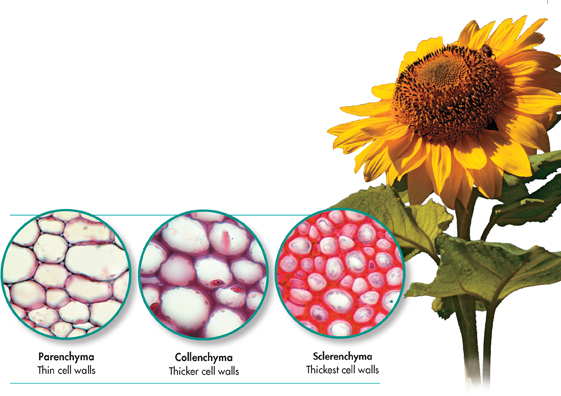Ground Tissue Plant tissue called ground tissue is neither dermal nor vascular.  Ground tissue produces and stores sugars, and contributes to physical support of the plant. Ground tissue is an important part of food at the dinner table, too. The edible portions of plants like potatoes, squash, and asparagus are mostly ground tissue. Most ground tissue consists of parenchyma (puh RENG kih muh). Parenchyma cells have a thin cell wall and a large central vacuole surrounded by a thin layer of cytoplasm. In leaves, these cells contain many chloroplasts and are the site of most of a plant's photosynthesis.
Ground tissue produces and stores sugars, and contributes to physical support of the plant. Ground tissue is an important part of food at the dinner table, too. The edible portions of plants like potatoes, squash, and asparagus are mostly ground tissue. Most ground tissue consists of parenchyma (puh RENG kih muh). Parenchyma cells have a thin cell wall and a large central vacuole surrounded by a thin layer of cytoplasm. In leaves, these cells contain many chloroplasts and are the site of most of a plant's photosynthesis.

FIGURE 23–3 Ground Tissue These micrographs show how three types of ground tissue found in a sunflower stem vary in thickness (LM 250X).
Ground tissue may also contain two types of cells with thicker cell walls. Collenchyma (kuh LENG kih muh) cells have strong, flexible cell walls that help support plant organs. Chains of such cells make up the familiar “strings” of a stalk of celery. Sclerenchyma (sklih RENG kih muh) cells have extremely thick, rigid cell walls that make ground tissue such as seed coats tough and strong. Sclerenchyma fibers are used to make rope from hemp, and when you last used a nutcracker to open a walnut, you broke through some really tough sclerenchyma!
 In Your Notebook Make a three-column chart in which to summarize information about the three main tissue systems of plants.
In Your Notebook Make a three-column chart in which to summarize information about the three main tissue systems of plants.
Plant Growth and Meristems
 How do meristems differ from other plant tissues?
How do meristems differ from other plant tissues?
When most animals reach adulthood, they stop growing. Not so with most plants. Even the oldest trees produce new leaves and new reproductive organs every year, almost as if they remained “forever young.” How do they do it? The secrets of plant growth are found in meristems, tissues that, in a sense, really do stay young.  Meristems are regions of unspecialized cells in which mitosis produces new cells that are ready for differentiation. Meristems are found in places where plants grow rapidly, such as the tips of stems and roots. The undifferentiated cells they produce are very much like the stem cells of animals.
Meristems are regions of unspecialized cells in which mitosis produces new cells that are ready for differentiation. Meristems are found in places where plants grow rapidly, such as the tips of stems and roots. The undifferentiated cells they produce are very much like the stem cells of animals.
MYSTERY CLUE

The seeds of this fig species sprout high up in the branches of other forest trees, called hosts. The roots grow downward, through the air.
Table of Contents
- Formulas and Equations
- Applying Formulas and Equations
- Mean, Median, and Mode
- Estimation
- Using Measurements in Calculations
- Effects of Measurement Errors
- Accuracy
- Precision
- Comparing Accuracy and Precision
- Significant Figures
- Calculating With Significant Figures
- Scientific Notation
- Calculating With Scientific Notation
- Dimensional Analysis
- Applying Dimensional Analysis




